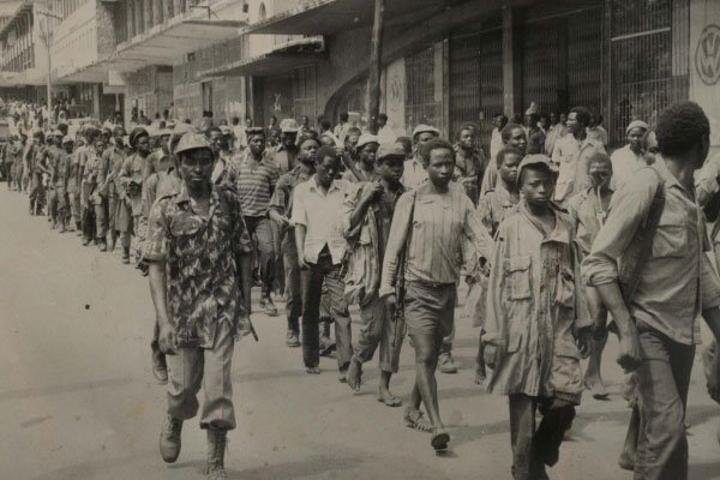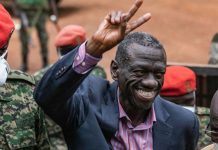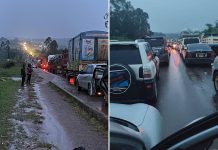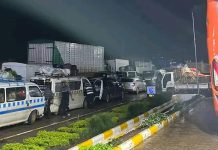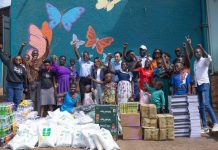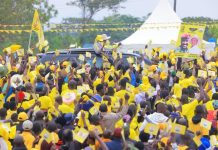Africa-Press – Uganda. As Uganda inched towards the 1980 general election, the Democratic Party (DP) was compelled to change leadership. The Military Commission warned, albeit subtly, that ousted former President, Prof Yusuf Kironde Lule would most likely be arrested if he dared return from exile. Dr Paul Kawanga Ssemogerere took charge.
It then became clear that the Uganda Peoples’ Congress (UPC), which had retained Apollo Milton Obote as it’s leader, and DP would be renewing a political rivalry that dated back to the pre-independence era.
UPC was however in an advantaged position. It had the backing of most of the men and officers of the Kikosi Maalum (special force), a fighting force of Uganda exiles that was formed by Obote and was under the command of former officers of the Uganda Army (UA), David Oyite Ojok, and Tito Okello, both of whom were very loyal to Obote.
The group had fought alongside the Tanzania People’s Defense Forces (TPDF) in the war that ousted Idi Amin. It later constituted the bulk of the Uganda National Liberation Army (UNLA).
DP desperately needed to counter that military might. The party approached Mr Museveni, the leader of the Front for National Salvation (FRONASA) whose fighters had also fought alongside the TPDF. He was also the vice chairman of the Military Commission chaired by Paulo Muwanga.
Third Force
However, at the time there was quite a number of academics and politicians, many of them former members of either DP or UPC, who were not comfortable returning to those parties. Others had never belonged to any party. They all needed new political homes. This batch of people soon called for the formation of a “third force”.
Mr Museveni was initially not part of the group that comprised of among others Akena P’Ojok, Erisa Kironde, Dr Ruhakana Rugunda, Mr Yona Kanyomozi, Dr Ezra Nkwasiibwe, Mr Jaberi Bidandi Ssali, Matia Kasaija, Bernard Buzaabo and Prof Tarsis Kabwegyere.
By May 1980, the group had zeroed in on the formation and launch of a new party, the Uganda Labour Congress, but a power struggle broke out.
The Interim Secretary General of DP, Mr Francis Bwengye, sought to cash in on the infighting to dissuade Mr Museveni from joining the “third force” and instead lure him to DP and enhance its capacity to contend with Obote and his UPC.
Mr Bwengye brokered a meeting with Mr Museveni at the Nile Mansions Hotel, where Mr Museveni had a suite.
The DP delegation was led by the Party’s National Chairman, Mr Boniface Byanyima and the President General, Dr Ssemogerere. On Museveni’s side was Dr Ruhakana Rugunda and Rev. Fr. Christopher Okoth. Turning down DPIn his book, “The Agony of Uganda: From Idi Amin to Obote”, Mr Bwengye indicates that Mr Museveni implied that he would have joined DP if the decision had been up to him alone, but that he had to take into consideration the feelings and thinking of some of his supporters.
“He, however, revealed that his supporters, who included members of Fronasa, regarded the DP as a party of Catholics and UPC as a party of Protestants and that they looked forward to the formation of a new political party which could not be identified with any of the major religions in the country,” Mr Bwengye wrote.
The DP delegation argued that it was a misconception driven by the fact that the party appealed to mostly members of the Catholic Church, which Mr Museveni countered with a suggestion that the party considers tweaking its name to accommodate members of the “third force”.
The meeting adjourned without striking an agreement, but DP remained open to welcoming Mr Museveni on board and invited him to attend its rally at the City Square now Constitutional Square the following day. He did not show up at the rally, but showed up for the party’s luncheon at the Imperial Hotel where a public invitation to extend the party was extended.
Mr Museveni has never come out to categorically give his own reasons for turning down DP, but gave a hint in July 2017 when he showed up a vigil that was organised following the death of former Kampala City Mayor and President General of DP, Mr John Ssebaana Kizito.
“I only left it [DP] after seeing political light of my future politics and you can see where I have taken the nation…” Mr Museveni said.
Uganda Patriotic Movement
A couple of days after the DP luncheon, it was announced that a new party, the (UPM) had been formed to contest the elections.
Mr Museveni emerged unopposed as the leader of the new party during elections held at the City Hall in Kampala after Mr Jaberi Bidandi Ssali, stepped down preferring, albeit belatedly, to become the party’s Secretary General.
Mr Bwengye stated in his book that the declaration of Mr Museveni as a leader was greeted with protests and a walkout staged by Prof Tarsis Kabwegyere, Prof Ephraim Kamuntu, Akena P’Ojok, Dr Ezra Nkwasiibwe and Mr Yona Kanyomizi, but there are conflicting accounts about what transpired.
Mr Kanyomozi, who was to later be named the Obote II Minister for Cooperatives and Marketing denies having stormed out of the said meeting, insisting that he stayed to the end.
“There was a protest, but it was not because of Mr Museveni.
It was over the election of a person to occupy the office of treasurer. Prof Kamuntu had been elected to become the treasurer, but members opposed the move saying they could not have a chairman and treasurer coming from the same region (western Uganda), but some people still nominated another person from western Uganda, which sparked off the protests and the walkout,” Mr Kanyomozi told Daily Monitor.
Prof Kabwegyere was so angry with the way the leadership was arrived at that he stormed out of City Hall.
“There were two organisations in that meeting, Save Uganda Movement and the Fronasa. We did not agree on how to elect the leader of the new organisation so members of the Save Uganda Movement including Yona Kanyomozi, Prof Kamuntu, Zed Maruru and Dr Nkwasibwe walked out of the meeting,” Prof Kabwegyere said.Mr Bwengye wrote that events at City Hall had compelled Prof Kabwegyere to join DP during a party meeting in Bushenyi, but the good Professor says that he was not the only one that returned to their old party.
“I announced that I was joining DP, but I had been DP before. Even when I was at Ntare School I was DP so I only returned to my party just like Prof Ephraim Kamuntu and Yona Kanyomozi returned to their old party, UPC,” he said.
The Elections
UPC was as expected declared winner of the 1980 elections with 75 seats in Parliament, followed by DP which had 50 seats. The newly registered parties, UPM and the Conservative Party (CP)came out with 1 and nil seats, respectively.
The UPM leader had faced off with Mr Guchwa Mingyi and his brother-in-law, Sam Kutesa of DP, for the Mbarara North seat. Mrs Janet Museveni and Mr Kutesa’s late wife, Jennifer, were cousins.
Kuteesa won with 15,657 votes. Mr Museveni came last with 12,682 votes in a race in which the UPC candidate came second with 12,747 votes.
Mr Museveni, who had throughout the campaign declared his intention to take up arms against the government if elections were rigged, filed through his lawyers, Hunter and Greg, an election petition in the High Court, listing 10 grounds for the annulment of the Mbarara election.
He argued that some of the registered voters did not appear on the voter’s register and that the registers were not displayed for inspection as required by the law. Bush WarThe petition turned out to be a decoy. It gave him a window to make preparations for the launch of the bush war with the National Resistance Army (NRA) making the first strike on Kabamba Military Training School on the dawn of February 6, 1981.
On the evening of December 2, 1983, the helicopter carrying the UNLA’s Chief of Staff, Maj Gen David Oyite Ojok, came down in the Luweero triangle shortly after a meeting in which he had laid out to the UNLA field commander a plan to wipe out the NRA.
Ojok’s death marked a turning point in the fortunes of the NRA. A rivalry between the Langi and Acholi officers in the army came to the fore.
The Langi dominated the officer corps while the Acholi were mostly the foot soldiers who suffered most casualties in the war against the NRA. That was already causing unrest among the Acholis some of whom had by the time of Ojok’s death started expressing an interest in engaging in talks with the rebels.
The decision by Obote in August 1984 to overlook several other senior officers like, Zed Maruru, Sam Nanyumba and Bazilio Okello and settle for a junior officer, Smith Opon Acak, as the Army Chief of Staff further alienated the Acholi officers.
The 1985 coup
On July 27 1985, Brig Bazil Olara-Okello staged a coup that deposed Dr Obote and placed power in the hands of a Military Council under the leadership of Gen Tito Okello Lutwa.
Gen Okello formed a government of national unity and invited all warring parties to join a national reconciliation and nation building effort. The other armed groups like the Federal Democratic Movement (FEDEMU), Uganda Freedom Movement (UFM), Former Uganda National Army (FUNA), the Uganda National Rescue Front (UNRF) heeded the call, but the NRA did not prompting Okello to draw in Mwalimi Julius Nyerere of Tanzania, but Mr Museveni skipped the first round of talks in Dar es Salaam.
Alternative arrangements were made for talks to be held in Kenya under the auspices of Kenyan President, Daniel Arap Moi. Negotiations commenced on August 26 and ended with the signing of the accord on December 17, 1985.
The accord made provisions for among others a ceasefire, the demilitarisation of Kampala, integration of NRA and government forces and absorption of the leadership of the NRA into the Military Council.
Upon his return to Kampala, Gen Okello who had earlier called Museveni a “snake” for “cheating” at war, thought that the accord had been cast in stone. He boasted that the accord had rendered a venomous viper impotent.
“Tume towa meno ya Salambwa,” (We have removed the fangs of the puff adder) he declared.
During the course of the negotiations however, NRA rebels, taking advantage of the chaos that the county had been plunged into, had gained ground taking over most of Western Uganda where they had established a government.
On December 28, 1985, 11 days after the accord had signed the External Wing of the NRM under the chairmanship of Mr Mathew Rukikaire, passed a resolution encouraging the fighting force to descend on the capital Kampala.
Dr Frank Nabwiso who was a member of the wing says that the biggest consideration was about the security situation in those parts of Uganda that were not under the control of the NRM/A.
“We feared that violation of basic human rights would continue because the military junta was unable to stop the various militias (UFM, FEDEMU, UNRF and FUNA) that were in Kampala from carrying out atrocities. We saw no organ that could reign in those armies,” Dr Nabwiso said.
At the same time the NRM’s administration in western Uganda was doing a commendable job of governing over the liberated area and they felt that the rest of the country could benefit from the same approach. Most important however, was that there was a fear that the leadership of the NRM could lose control over its fighting group, the NRA.
“There was a fear that the NRA could actually overthrow the leadership of the NRM. There was a real possibility that the revolution could be lost. Mr Museveni was out of the country (Uganda) and his brother, (Gen Salim Saleh) had emerged as the defecto leader,” Dr Nabwiso says.
The decision culminated into the return of Mr Museveni to the war theatre and the subsequent takeover of Kampala in January 1986.

